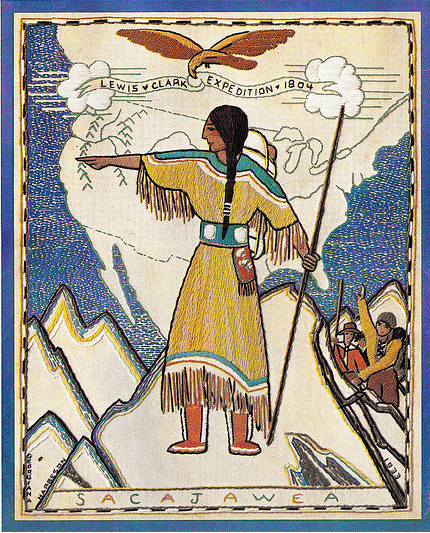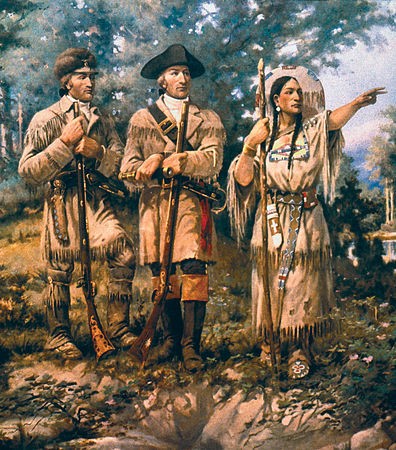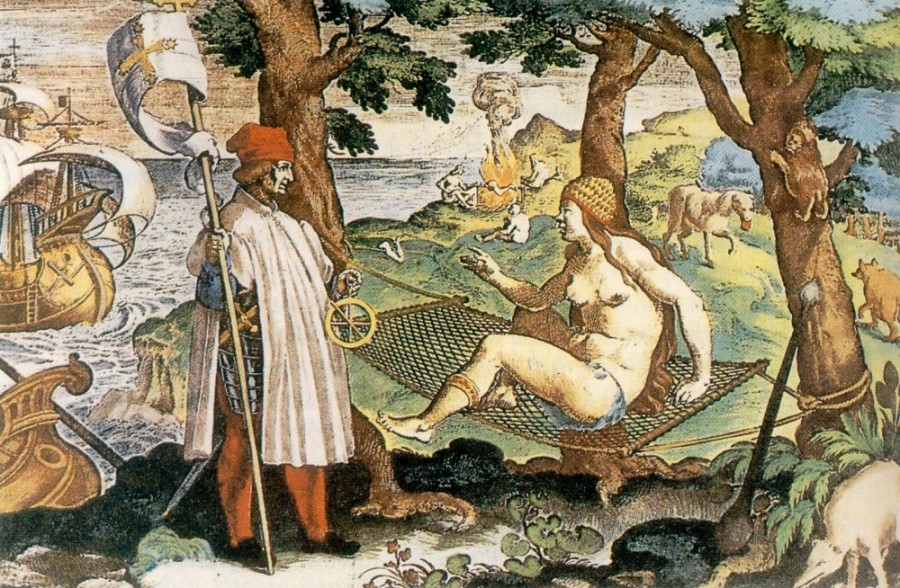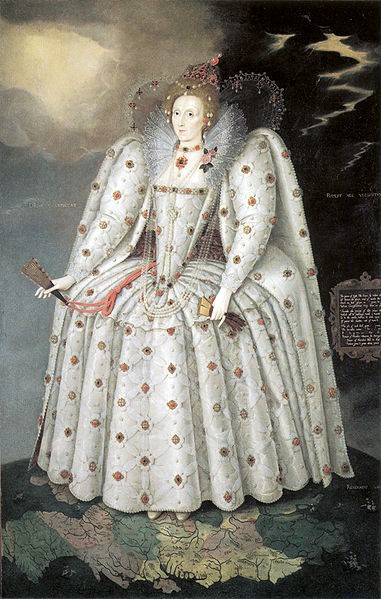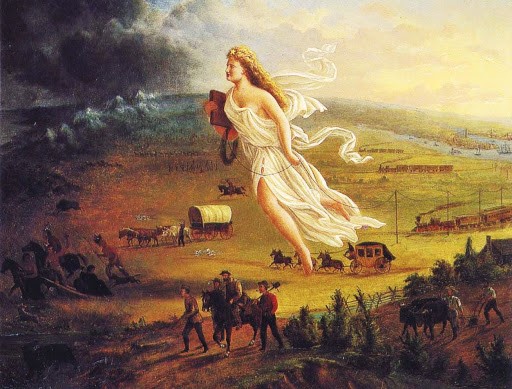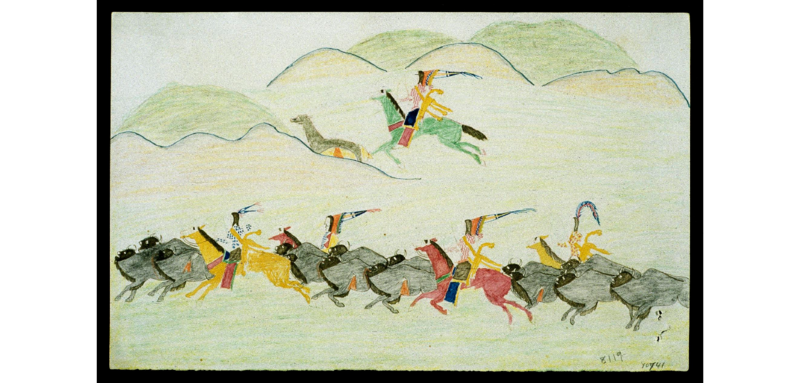Sacajawea: Comments of the Website cover image
by Gesa Mackenthun, 03/10/2016.
Summary
Our cover image reproduces a needle art tapestry by Georgiana Brown Harbeson (1894-1980), entitled “Sacajawea” and published as the cover of Needlecraft. The Home Arts, a magazine for needle art, in July, 1933. Harbeson was a pioneer of modern needlework which appeared on many magazine covers in the 1920s and 1930s. She also produced oil paintings with pastoral motives. Harbeson raised needlecraft to a real art form. Her work has been exhibited by the Metropolitan Museum of Art in New York.
Our cover image reproduces a needle art tapestry by Georgiana Brown Harbeson (1894-1980), entitled “Sacajawea” and published as the cover of Needlecraft. The Home Arts, a magazine for needle art, in July, 1933. Harbeson was a pioneer of modern needlework which appeared on many magazine covers in the 1920s and 1930s. She also produced oil paintings with pastoral motives. Harbeson raised needlecraft to a real art form. Her work has been exhibited by the Metropolitan Museum of Art in New York.[1]
We find her image of Sacajawea intriguing for various reasons. The representation of Lewis and Clark’s indigenous guide, the Lemhi Shoshone woman Sacajawea, significantly differs from her conventional representations where (Fig. 1) she is of the same size, or smaller, than the white explorers.
Instead of merely standing on an elevated piece of ground as in other paintings, Sacajawea here hovers above the Rocky Mountains, and above the whole semi-hemisphere of North America, while Lewis and Clark are hiding behind a rock like two little boys playing hide and seek. Read in terms of the colonial trope of the feminization of America, the figure of the Native woman differs remarkably from that of Theodor Galle’s “America” of 1589 where America is symbolized by a naked woman welcoming the armed figure of Amerigo Vespucci into her hammock (Fig. 2).
Rather than imitating this erotic and submissive position, Harbeson’s Sacajawea is more reminiscient of two well-known white female figures: that of Queen Elizabeth I in the famous Ditchley Portrait, where Elizabeth, the “Virgin Queen” and founder of the British Empire, stands imperially on a map of England (Fig. 3), and of John Gast’s allegory “American Progress” of 1872/74 where Lady Columbia hovers above the landscape holding in her arm the paraphernalia of civilization, a schoolbook and the telegraph line, bringing light and knowledge to the darkness of the West (Fig. 4).
Read against this painting by Gast, Harbeson transfers the posture of the female representative of empire to the indigenous guide Sacajawea. In combination with the reduction of the visibility of the white male explorers, this can be read as a subversive gesture. The image foregrounds the agency of the indigenous pathfinder and interlocutor whose agency has mostly been suppressed in colonial texts; but it also represents her as a ruler of the landscape of North America.[2]
Moreover, the geographical area to which Sacajawea is pointing, the Pacific Northwest – which of course was the destination of the Lewis and Clark expedition in 1805[3] – also happens to be the area where many antiquity-related sites and stories investigated by our research team are located. It is one of the oldest cultural areas of North America. This is where the skeleton of the “Kennewick Man”/The Ancient One was discovered. This is where Sasquatch (Bigfoot) roams through the deep forests.
While searching for the origin of the artwork by feeding it into the American Indian Workshop website in July 2015, an interesting discussion about the image ensued with a Native American colleague at Utah, Franci Lynne Taylor. Franci reported that she had shared the image with other Native American women scholars and that is had created “great dialogue.” Some of her colleagues critiqued Sacajawea’s clothing as not being traditionally Mandan (the tribe with whom Sacajawea had stayed as the wife of the Frenchman Toussaint Charbonneur when Lewis and Clark met her). Many of them were especially dissatisfied with the woman’s pointing finger and rejected this imperial gesture completely. I (G.M.) suggested to read the image as the product of a colonial contact zone which inverts the colonial power situation: the diminutive position of Lewis and Clark, who are hiding like children behind a rock while Sacajawea stands towering over the landscape. I suggested that the tapestry was neither PC nor anti-imperialist, but perhaps a bit feminist, and in any case suggesting who had the say and the local knowledge in traveling in those lands. Franci replied that “the general consensus [among her colleagues] was that there are so many subtle messages in the image that reflect today’s interpretation that it is difficult to begin to deconstruct the intent.”[4] And she provided one of the most important intertextual references that had escaped me, one with a non-western origin: she suggested that the style of the image looked as if it was inspired by the Fort Marion ledger drawings.
These are drawings (Fig. 5) that were produced by Native Americans at the end of the “Indian Wars” while incarcerated in prison camps: “many Cheyenne and others were sent to the Prisoner of war camp at Fort Marion,” Franci explains: “because there were so many ‘warriors’ housed there to keep them busy they were given ledger and other scraps of paper to draw their stories and life histories on. This became known as the Fort Marion Ledger Art. Ledger Art was then renewed by the ‘Kiowa Seven’ and others in the early days of the American Indian Art Movement. It is one of the most common tropes used in American Indian art today.”
Thank you, Franci, for sharing this important information with us! As the example shows, intellectual exchange greatly enhances our understanding of our material.
NOTES
[1] “Georgia Brown Harbeson.” James E. Michener Art Museum. Online. http://www.michenermuseum.org/bucksartists/artist.php?artist=101 (accessed 03/09/2016)
[2] Harbeson did a whole series of tapestries of Native American women, among others Pocahontas and “Minnehaha” based on Longfellow’s epic poem Hiawatha. See http://www.carolynagner.com/embroidery/2012/georgiana_covers.htm
[3] The national borders visible on the map, by the way, are not those of 1805 but of the 1930s.
[4] Email correspondence GM with Franci Lynne Taylor, July 2015.
ILLUSTRATIONS
Figure 1: Edgar Samuel Pacson, “Lewis & Clark at Three Forks” (1912, detail). Source: Wikipedia.
Figure 2: Theodor Galle/Jan van der Straet, Vespucci discovering America (1589). Source: The complete Nova Reperta Online (University Liège, Belgium).
Figure 3: Marcus Gheeraerts the Younger, Queen Elizabeth I (1592) (“Ditchley portrait”). National Portrait Gallery, London. Source: Wikipedia.
Figure 4: John Gast, “American Progress” (1872/74). Source: Wikipedia.
Figure 5: Drawing of buffalo hunting by Shave Head, or O-uk-ste-uh (Cheyenne), drawn between 1875 and 1878 at Fort Marion, Florida. Source: Sarah Coffee, “A closer look at the Plains Indian Ledger Drawings for American Indian Heritage Month.” 11/21/2012. http://americanhistory.si.edu/blog/2012/11/a-closer-look-at-the-plains-indian-ledger-drawings-for-american-indian-heritage-month.html

